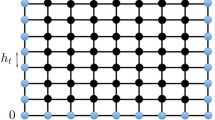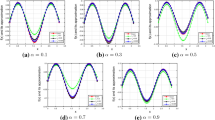Abstract
In this paper, we consider the inverse problem for identifying the source term and initial value for time-fractional diffusion equation on spherically symmetric domain with Caputo–Hadamard fractional derivative. By solving the direct problem, the exact solutions of the problem can be calculated, and based on the expressions of the exact solutions, it can be analyzed that this problem is ill-posed. To address this, we employ the fractional Landweber iterative regularization method to restore the stability of the solutions. Furthermore, the error estimates under the priori regularization parameter choice rules and the posteriori regularization parameter choice rules are given, respectively. Finally, different numerical examples are presented to demonstrate the validity and effectiveness of our method.




Similar content being viewed by others
Data availability
Not applicable.
References
Ahmad B, Alsaedi A, Ntouyas SK et al (2017) Hadamard-type fractional differential equations, inclusions and inequalities. Springer International Publishing, Cham Switzerland
Atangana A (2012) Numerical solution of space-time fractional derivative of groundwater flow equation. In: Proceedings of the international conference of algebra and applied analysis, vol 2(1), p 20
Atangana A, Kilicman A (2013) Analytical solutions of the space-time fractional derivative of advection dispersion equation. Math Probl Eng 2013:87–118
Bourgeois L (2006) Convergence rates for the quasi-reversibility method to solve the Cauchy problem for Laplace’s equation. Inverse Probl 22(2):413
Caputo M (1967) Linear models of dissipation whose Q is almost frequency independent-II. Geophys J Int 13(5):529–539
Chen CM, Liu F, Turner I et al (2007) A Fourier method for the fractional diffusion equation describing sub-diffusion. J Comput Phys 227(2):886–897
Chen W, Ye LJ, Sun HG (2010) Fractional diffusion equations by the Kansa method. Comput Math Appl 59:1014–1620
Eidelman SD, Kochubei AN (2004) Cauchy problem for fractional diffusion equations. J Differ Equ 199(2):211–255
Fan E, Li C, Li Z (2022) Numerical approaches to Caputo-Hadamard fractional derivatives with applications to long-term integration of fractional differential systems. Commun Nonlinear Sci Numer Simul 106:106096
Feng XL, Eldén L (2014) Solving a Cauchy problem for a 3D elliptic PDE with variable coefficients by a quasi-boundary-value method. Inverse Probl 30(1):015005
Gorenflo R, Luchko Y, Yamamoto M (2015) Time-fractional diffusion equation in the fractional Sobolev spaces. Fract Calc Appl Anal 18:799–820
Hadamarad J (1892) Essai sur l’étude des fonctions, données par leur développment de Taylor. J Pure Appl Math 8:101–186
Haubold HJ, Mathai AM, Saxena RK (2011) Mittag–Leffler functions and their applications. J Appl Math 2011:36–47
Henry BI, Langlands TAM, Wearne SL (2008) Fractional cable models for spiny neuronal dendrites. Phys Rev Lett 100(12):128103
Jiang SZ, Wu YJ (2021) Recovering space-dependent source for a time-space fractional diffusion wave equation by fractional Landweber method. Inverse Probl Sci En 29(7):990–1011
Jumarie G (2005) On the solution of the stochastic differential equation of exponential growth driven by fractional Brownian motion. Appl Math Lett 18(7):817–826
Jumarie G (2006) Modified Riemann–Liouville derivative and fractional Taylor series of nondifferentiable functions further results. Comput Math Appl 51(9–10):1367–1376
Kilbas AA, Srivastava HM, Trujillo JJ (2006) Theory and applications of fractional differential equations. Elsevier, Amsterdam
Landweber L (1951) An iteration formula for Fredholm integral equations of the first kind. Am J Math 73(3):615–624
Li XX, Lei JL (2014) Yang F (2014) An a posteriori Fourier regularization method for identifying the unknown source of the space-fractional diffusion equation. J Inequal Appl 1:1–13
Li C, Li Z, Wang Z (2020) Mathematical analysis and the local discontinuous Galerkin method for Caputo–Hadamard fractional partial differential equation. J Sci Comput 85(2):1–27
Li C, Li Z, Wang Z (2020) Mathematical analysis and the local discontinuous Galerkin method for Caputo–Hadamard fractional partial differential equation. J Sci Comput 85:1–27
Lin Y, Xu C (2007) Finite difference/spectral approximations for the time-fractional diffusion equation. J Comput Phys 225(2):1533–1552
Podlubny I (2002) Geometric and physical interpretation of fractional integration and fractional differentiation. Fract Calc Appl Anal 5(4):367–386
Podlubny I, Kacenak M (2001) The Matlab mlf code. MATLAB Central File Exchange 2012
Pollard H (1948) The completely monotonic character of the Mittag–leffler function \(E_{\alpha }(-x)\). B Am Math Soc 54:1115–1116
Samko SG, Kilbas AA, Maritchev OI (1987) Integrals and derivatives of fractional order and some of their applications
Sandev T, Metzler R, Tomovski Ž (2011) Fractional diffusion equation with a generalized Riemann-Liouville time fractional derivative. J Phys A-Math Theor 44(25):255203
Tikhonov AN (1963) On the solution of ill-posed problems and the method of regularization. Dokl Akad Nauk 151(3):501–504
Wei T, Wang J (2014) A modified quasi-boundary value method for an inverse source problem of the time-fractional diffusion equation. Appl Numer Math 78:95–111
Xiong X, Xue X, Qian Z (2017) A modified iterative regularization method for ill-posed problems. Appl Numer Math 122:108–128
Yang F, Fu JL, Fan P et al (2021) Fractional Landweber iterative regularization method for identifying the unknown source of the time-fractional diffusion problem. Acta Appl Math 175:1–19
Yang F, Wu HH, Li XX (2022) Three regularization methods for identifying the initial value of time fractional advection-dispersion equation. Comput Appl Math 41(1):60
Yuste SB, Lindenberg K (2002) Subdiffusion-limited reactions. Chem Phys 284(1):169–180
Zhang ZQ, Wei T (2013) Identifying an unknown source in time-fractional diffusion equation by a truncation method. Appl Math Comput 219(11):5972–5983
Funding
The project is supported by the National Natural Science Foundation of China (No.11961044), and the Natural Science Foundation of Gansu Province (No. 21JR7RA214).
Author information
Authors and Affiliations
Contributions
The main idea of the article is given by Chen-Yu Zhang and Fan Yang. We confirmed the steps of the article. This view is shared by all the authors.
Corresponding author
Ethics declarations
Conflict of interest
The authors declare that they have no conflict of interest.
Ethical approval
Not applicable.
Additional information
Communicated by Vinicius Albani.
Publisher's Note
Springer Nature remains neutral with regard to jurisdictional claims in published maps and institutional affiliations.
Rights and permissions
Springer Nature or its licensor (e.g. a society or other partner) holds exclusive rights to this article under a publishing agreement with the author(s) or other rightsholder(s); author self-archiving of the accepted manuscript version of this article is solely governed by the terms of such publishing agreement and applicable law.
About this article
Cite this article
Zhang, CY., Yang, F. & Li, XX. Identifying the source term and the initial value simultaneously for Caputo–Hadamard fractional diffusion equation on spherically symmetric domain. Comp. Appl. Math. 43, 161 (2024). https://doi.org/10.1007/s40314-024-02679-6
Received:
Revised:
Accepted:
Published:
DOI: https://doi.org/10.1007/s40314-024-02679-6
Keywords
- Caputo–Hadamard fractional diffusion equation
- Spherically symmetric domain
- Fractional Landweber iterative regularization method
- Unknown source and initial value
- Inverse problem




